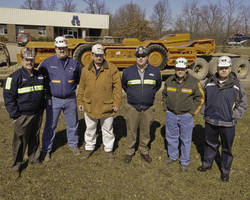Joy Mining Machinery Ships 500th OPTIDRIVE Shuttle Car
Share:

Joy Mining Machinery marked a milestone in the history of their most successful underground haulage machine with the shipment in February of the 500th JOY OPTIDRIVE shuttle car to Massey Energy's, Martin County Coal Corporation, Voyager Mine in Inez, Kentucky.
The shuttle car was invented and first produced in 1938 by Joy Mining Machinery, and over the past seven decades more than 16,000 JOY shuttle cars have been sold around the world, according to Doug Anderson, Engineering Technologist. "Today, there are more than 3,000 JOY shuttle cars currently operating in underground mines globally," he said, "about half of them in North and South America. I would venture to say that shuttle cars account for nearly 80% of all haulage machines now being employed in the world today."
"In celebrating the most recent auspicious occasion," Anderson said, "it should be noted that, when introduced to its shuttle car line in 2003, OPTDRIVE at the time was a major breakthrough in applying AC variable frequency drive technology, one that has resulted in significant increases in power, speed, and productivity."
According to Anderson, with OPTIDRIVE, the shuttle car's top speed had been increased a full 50%, from approximately 4 mph (6.4 km/hr) to 6 mph (9.6 km/hr), the top speed allowed by international standards. "This half-again increase in speed can be translated into a 10% gain in mine production which, to the mine operator, typically can mean five additional loads per shuttle car, per shift," he said.
As explained by Anderson, in its earliest configuration, the shuttle car was a battery-powered, two-wheel drive and two-wheel steering machine. Both drive wheels on opposing sides of the shuttle car each were powered by a DC motor, as were the discharge conveyor and the machine's hydraulics. "Because of the limited power capacity of batteries, and its short life when mining conditions included muddy bottom and steep grades, Joy soon switched to direct DC power feed utilizing DC trailing cables and cable reels," Anderson said.
The DC shuttle car's low operating voltage (250v) required proportionally higher currents to given work loads, and those higher currents required increasingly larger sized switching components, cabling, and trailing cables. Because of this, by 1980 much of the old onboard, high current, high maintenance DC switchgear had been replaced with solid-state transistors, Anderson said.
"Still," he added, "DC motors had other disadvantages. Increased machine loads and operating on grades tended to decrease DC tram speeds while increasing heat in cables and motors. Additionally, DC tram systems offered little speed control while descending grades, necessitating the use of mechanical braking systems. And further, DC motors by their nature require periodic cleaning and brush replacement, as well as rebuild as the commutators wore."
As AC power systems for the higher horsepower equipment became more common in underground mines, Anderson said Joy developed an AC system for shuttle cars that provided AC hydraulic and conveyor discharge motors, which, he said, has the advantages of high power, constant speed, and low maintenance, and a traction system using two-speed AC motors. "These motors provided the increased power and torque with which to negotiate adverse bottom conditions and steep grades," he said, "while neither losing nor gaining any noteworthy speed as long as the tram was engaged, thus reducing the dependence on mechanical braking systems.
"However, this AC characteristic to control speed that solved the problem of gaining speed on the downgrade experienced with DC motors, created the problem of difficulty in steering around corners. While under power, the wheels on the inside of the turn radius and those on the outside turn radius would try to turn at the same speed, causing the AC drive shuttle car to "plow" through a corner, with resultant roadway wear and reduced control."
According to Anderson, in solving this problem in the mid 1970s, Joy combined the better of both worlds by developing its patented AC/DC tram system that allowed the shuttle car to be powered by the higher voltage AC trailing cable (typically 440v to 550v) and, by means of an onboard transformer and diode, bridge to DC tram motors. "This arrangement allowed the use of AC pump and conveyor motors and lower currents," he said, "as well as using lower-maintenance AC switchgear, and it offered the smooth acceleration, control, and turning capability of DC tram motors.
"This AC/DC tram design," he continued, "became the standard of the industry-today it still accounts for nearly 80% of the currently active shuttle cars-and remained so until 2003 when Joy first adapted its proven OPTIDRIVE AC VFD (variable frequency drive) system to shuttle cars and brought the smoothness of DC tram drive to AC motors, taking the better of the two and making the best out of both."
Joy first introduced a 575v AC VFD in 1998 on both the JOY longwall shearer and JOY continuous miner, Anderson said. Further developments and technological advances led to the next generation 950v OPTIDRIVE AC VFD being applied to the JOY Flexible Conveyor Train in 2002 and then to the JOY model 10SC32B shuttle car in 2003, followed by a low voltage (440/550v) OPTIDRIVE AC VFD 10SC32AA shuttle car later that year.
"A major operator advantage with the OPTIDRIVE AC VFD is its interchangeability, negating the need to inventory multi-system replacement parts," Anderson said. "The 1000v OPTIDRIVE hardware is common to the 950v and 1050v continuous miner, FCT, and the shuttle car, while a 440/550v OPTIDRIVE version currently is used for low voltage shuttle cars.
"In either design, the OPTIDRIVE AC VFD tram system provides the power and speed control that enables the JOY shuttle car to easily climb and descend grades and to traverse soft bottoms," he said. "Through this combination of variable frequency drive and AC motor design, the entire line of JOY shuttle cars-from the worlds largest to those designed for the lower seams-has but two motors covering the full range of voltages.
"The OPTIDRIVE system provides smooth acceleration and turning characteristics as the system adjusts and controls individual wheel speed while, at the same time, providing increased tram speeds. OPTIDRIVE also provides the advantage of regenerative braking for downgrade speed control for increased ease of operation, improved safety and lower brake maintenance and replacement," he said.
Anderson noted that all this is accomplished without the aid of an onboard power transformer, as the AC motors for each set of drive wheels operates on the 3-phase provided to the VFD drives from the AC trailing cable.
"The incoming AC to the OPTIDRIVE is rectified internally to DC voltage and internal solid-state devices convert DC voltage back into AC waveform output as the operator depresses or releases the footswitch, operating the foot pedal much like the gas pedal in an automobile," he explained. "Changes to tram direction are accomplished within the OPTIDRIVE unit, there are no reversing contactors, and the VFD units also provide motor overload protection. Joy reports very significant gains in traction motor life since introduction of the OPTIDRIVE AC VFD system due to this protection and also to the inherent reliability of brushless AC motors compared to DC.
"From its introduction to shuttle cars in 2003, when it factored into about 15% of JOY shuttle car sales, OPTIDRIVE AC VFD has become standard equipment on all JOY shuttle car models," Anderson said. "Last year it accounted for almost 100% of the JOY shuttle cars sold. That," he said, "is a remarkable technological achievement."




